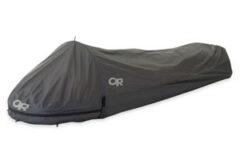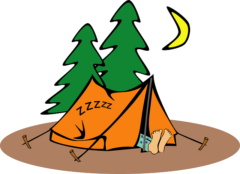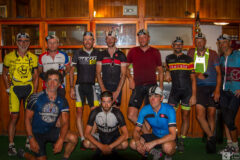In multi-day bikepacking races in which the clock never stops, choosing when to sleep, where, for how long and what sleeping equipment to bring is extremely important.

Page Contents:
Amount of Sleep
The amount of sleep needed and the best time to have it during ultracycling races varies widely between people. The serious racers sleep just enough so that they don’t get too drowsy on the bike, and not any more. This often means one block of 2-3 hours of sleep on most, but not all, nights plus some short power naps during the day, with even less sleep during the first and last days.
Riders in the middle of the pack of bikepacking races will often sleep for 4-6 hours per night plus an occasional daytime nap, which is what I normally aim for. I’m always surprised at how well my body adapts to averaging about 2 hours less per night than normal for a couple of weeks without causing much of a problem with tiredness. Ideally, finding out how much sleep you need is something that should be decided during Multi-Day Training Rides and not during a race situation.
It can be difficult to get out of a comfortable bed on some mornings, possibly hours before the sun rises. For most people, the alarm on their smartphone is enough to wake them, but others need to use a wristwatch alarm as a backup.
Cycling while sleep deprived can be extremely dangerous so there is a page devoted to Sleep Deprivation in the Rider Safety section of this website. Research shows that car drivers who have had less sleep the night before are more likely to have a car crash than people who have had more sleep. Tiredness can cause more of an impairment to driving ability than a moderate amount of alcohol, but the social stigma attached is quite different.
People in bikepacking races sometimes report trying to push on when they are very tired and occasionally falling asleep on the bike, crashing and getting injured, so you should be very cautious. There are also many stories from ultracyclists of vivid hallucinations while on the bike due to a severe lack of sleep. When riding while extremely tired, you’ll be going much slower than normal, so taking a short nap will not only make you safer but you’ll probably quickly make up the lost time by being able to ride much faster afterwards.
Sleeping Location
Exactly where along your route you choose to sleep can be an important decision. If you arrive in a large city late in the evening and plan to leave during the rush hour the next morning, then I recommend staying on the far side of the city to avoid most of the traffic. If you are in the mountains then you will get slightly better recovery if you sleep at a lower elevation where there is more oxygen and it’s probably warmer. It’s also not a good idea to start an early morning ride with a long descent if you haven’t had any chance to warm up beforehand. On the other hand, it’s not ideal to sleep at the base of a big climb because you may want to start with some easier pedaling to get the legs and joints warmed up before tackling anything steep.
The two main types of accommodation used by bikepackers are hotels and sleeping outside. Staying in a property owned by friends or family is against the rules of being self-supported. Staying in the house of people you randomly meet along the route is not against the rules since the option should be equally available to all racers (even if it is non-commercial), but this is often not the most time efficient option. Most bikepackers use a mixture of sleeping options – sleeping outside some nights and in hotels when it is convenient and/or when they need to get themselves and their gear properly washed, and that would be my recommendation for how to complete the race in the most time efficient manner while occasionally having some comfort.
Hotels
Hotels offer many advantages that include having a shower and bathroom, power sockets, and (normally) a decent bed to sleep in. If the weather is cold or wet then hotels offer even more advantages. The disadvantages of hotels are that you can lose time looking for the hotel, checking in, and you may have to do a lot more or a lot less distance each day because your options of where to stop may sometimes be limited. Hotels also cost money and may add anxiety concerning whether or not you’ll find one in a particular town and whether they’ll have a room available. Resort towns obviously have many hotels, but it still may be difficult to find a room on a weekend night in the middle of summer.
On the nights when I plan to sleep in a hotel, I try to not stop too late in the evening so that finding a hotel, checking in, and finding something to eat nearby is straightforward because everything is still open. I prefer to do that and then leave the hotel extremely early in the morning rather than searching for accommodation late at night after many of the hotel receptions and restaurants might have closed. If you stop earlier than normal one night then you haven’t lost that time if you compensate by starting earlier the next day, you are instead just giving some of the time of the current day away to the next day.
Phone apps and websites like Booking.com or Expedia can be useful ways to make reservations, but they don’t include every hotel, and not all hotels make all of their rooms available to those sites. Therefore, don’t give up if those websites show no availability in a certain region – you might still get lucky and find an unlisted hotel when you get there. GPS Bike Computers often list hotels under the POI (Points Of Interest) option and can help you to navigate to them. I was surprised how well this worked even in Albania as it pointed me to a building that I’d seen but not realized was a hotel, but it turned out to be exactly what I needed.
Most hotels have a room or garage to store your bike for the night, and some will let you bring it into your room. I’ve heard several stories about bikes being stolen from “secure” hotel parking, so I recommend locking your bike whenever you leave it (see the Bikepacking Bags, Fenders & Locks page for options). Some people therefore insist on bringing their bike into their room, which sometimes requires having an argument with the hotel staff, so I personally only do this when it is suggested by the staff. There have also been multiple stories about racers being delayed in the morning due to not being able to retrieve a bike from a locked room, even when the departure time was agreed with the hotel staff the night before.
For a more amusing take on this topic that includes a LOT of truth, read this post by Jonah Jones on the TCR Facebook group.

Camping / Sleeping Outside
Sleeping outside can save significant time compared to finding a hotel and getting checked in. Official campgrounds can sometimes be convenient, but unfortunately many of them share many of the disadvantages of hotels (time spent finding them, checking in, etc.), without offering the same advantages (except at least there are showers and toilets). They can also have the added disadvantage of being noisy when you want to sleep.
It’s therefore more common for bikepackers to “wild-camp”, which means camping outside of official campgrounds. This has the advantage of being very quiet (as long as you don’t stop right next to a busy road or in a town) and in most rural areas you can find a suitable location directly on your route within 5-10 km of starting to look for one. If you’re comfortable doing it then this is probably the most time-efficient way of getting some rest. If you’re not familiar with doing it then you may find it hard to find a suitable location and you may not rest very well because you are too worried about what might happen to you. I therefore recommend incorporating such experiences into Multi-Day Training Rides.
There are some regions where no suitable, stealthy wild camping locations are available due to the type of terrain or land use, but the more often you wild camp then the better you become at finding good places or knowing in which regions not to even bother looking for something. Woods, beaches, parks, the edges of fields, and areas of disused land are among the possibilities.
In most regions, wild camping without the consent of the land owner is officially illegal. Obviously, the location should be left as close as possible to how you found it, and you should try not to attract attention to yourself. When done correctly, the chance of anyone seeing you should be virtually zero. If someone does notice what you’re doing then if they are not the landowner then they probably won’t care, or they may just come to say Hello. If a landowner does notice you then there is a small chance that they will ask you to leave, but this is almost never done in an aggressive way. I’ve wild camped possibly 100 times in Europe, North America, and Australasia, without anyone ever approaching me, and I’m only aware of being noticed less than 5 times. If you are concerned then you can ask the landowners for permission to camp on their land, which often results in them directing you towards the nicest available location and very rarely results in a rejection.
I prefer to sleep in hidden rural locations, but other people prefer to sleep in urban areas: next to commercial buildings, at bus stops, abandoned buildings, or anywhere else they find that offers some shelter. Often they don’t try to hide themselves at all, and again they very rarely get approached by anyone, and it’s even rarer that they are asked to leave. People sometimes just lay down by the side of the road in view of everyone for a short sleep. I have heard multiple stories of people in those situations being approached by locals who are worried that they’ve been in an accident or need some help, so it’s probably better to move further away from the road if you want more peace.
Most people are very nervous the first few times they sleep outside, but they soon realize that there really isn’t anything to worry about. In most parts of Europe, there are no longer any dangerous animals like wolves or bears. There are a few more remote and wilder regions of Europe where a few dangerous animals remain, but they generally avoid human contact, so there is nothing to worry about even there. In addition, acts of violence by humans against people who are wild camping are rare enough to not even be worth considering (despite our imaginations being excellent at concocting all sorts of terrible visions).
Sleeping Equipment
The amount of sleeping equipment carried by bikepackers varies as much as their sleeping strategies. Even for people who plan to sleep in a hotel every night, I strongly recommend having a backup plan in case you arrive in a town and all the hotels are full or if you are too tired to go further and there are no hotels for a long distance. The minimum would be to bring an emergency blanket (Amazon), which weighs less than 100 grams and costs almost nothing.
An emergency blanket should ensure that you can survive a night outdoors during the summer if necessary without any serious problems, but if sleeping outside is part of your plan then I recommend bringing a small amount of sleeping gear to make the experience more comfortable. At the other end of the extreme from a simple emergency blanket is bringing a tent, sleeping bag, sleeping mat, and pillow. Many people delete one, two, or three of these items depending on the degree of comfort that they desire and can tolerate. Most setups weigh between 0.5 and 1.5 kg, so will cost 20-60 minutes in riding time over the complete route (see The Actual Effect of Weight on Cycling Speed page), which could easily be gained back by being better rested.

I used a very small and lightweight tent for my first race in 2014, but was frustrated by the amount of time that it took to assemble and repack, and so sometimes only used it as a groundsheet to lay on top of. In later races, I used a bivvy bag, an Outdoor Research Helium (Amazon), that is far quicker to setup and is even easier to find a place to stealthily wild camp with. I like the Helium bivvy because it has an optional pole to hold the material away from my face, gives decent protection from the elements and breathes reasonably well, but there are many other good options, see here.
To ensure a comfortable rest, I use an inflatable mat with an integrated pillow, the Klymit Inertia X-Wave (Amazon), whose best attribute is how compact it is when deflated. The sleeping bag that I use in the summer is very minimal and weighs under 400 grams, an OMM Mountain Raid 1.0 (Amazon). I can always wear more clothes and if I expect it to be particularly cold then I’m likely to search for a hotel instead.
Some bikepackers take a bivvy bag with nothing to go inside or only something tiny like a sleeping bag liner. Other people leave the bivvy bag / tent at home and only bring a sleeping bag, and then search for somewhere covered or don’t sleep outside when it’s wet. Another option is a hammock, which some people find to be very comfortable, but is more limited in where it can be used. There are multiple options of what to use for a pillow, including extra clothes, a bike helmet, etc.
Last significant page update: December, 2017

This is the final page in the Mental Approach & Strategy section, which is in Ride Far, Part I: The Rider.
